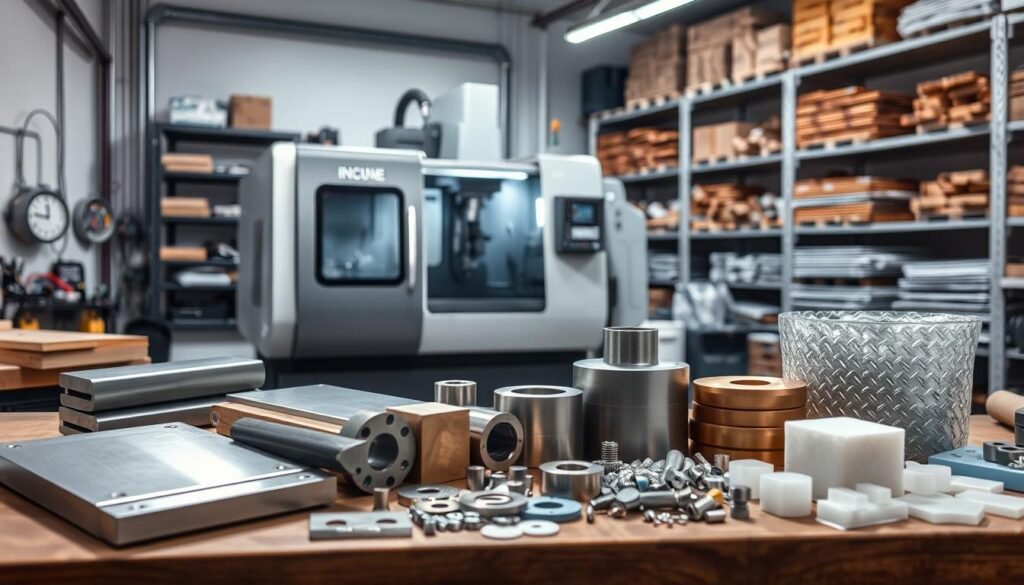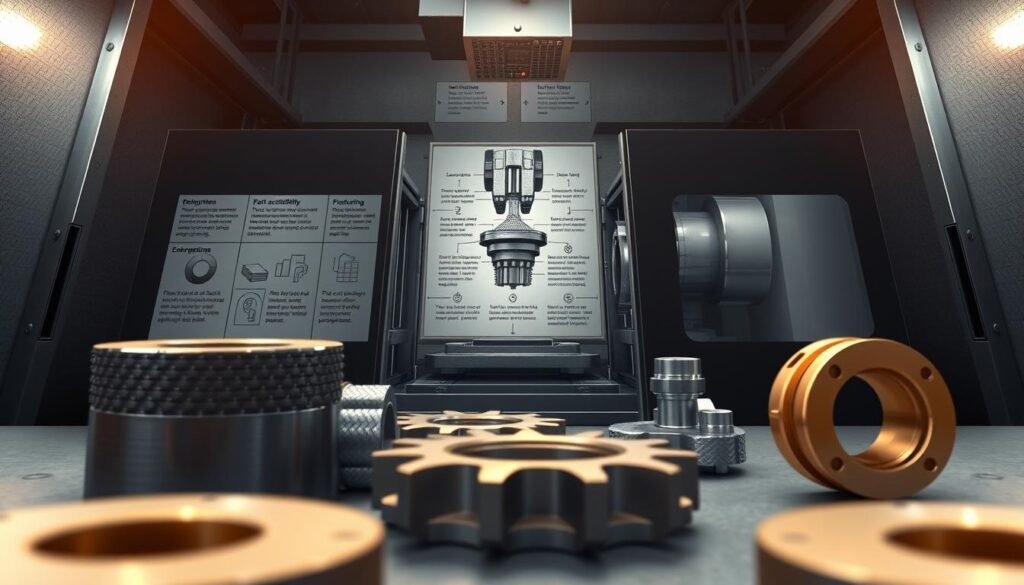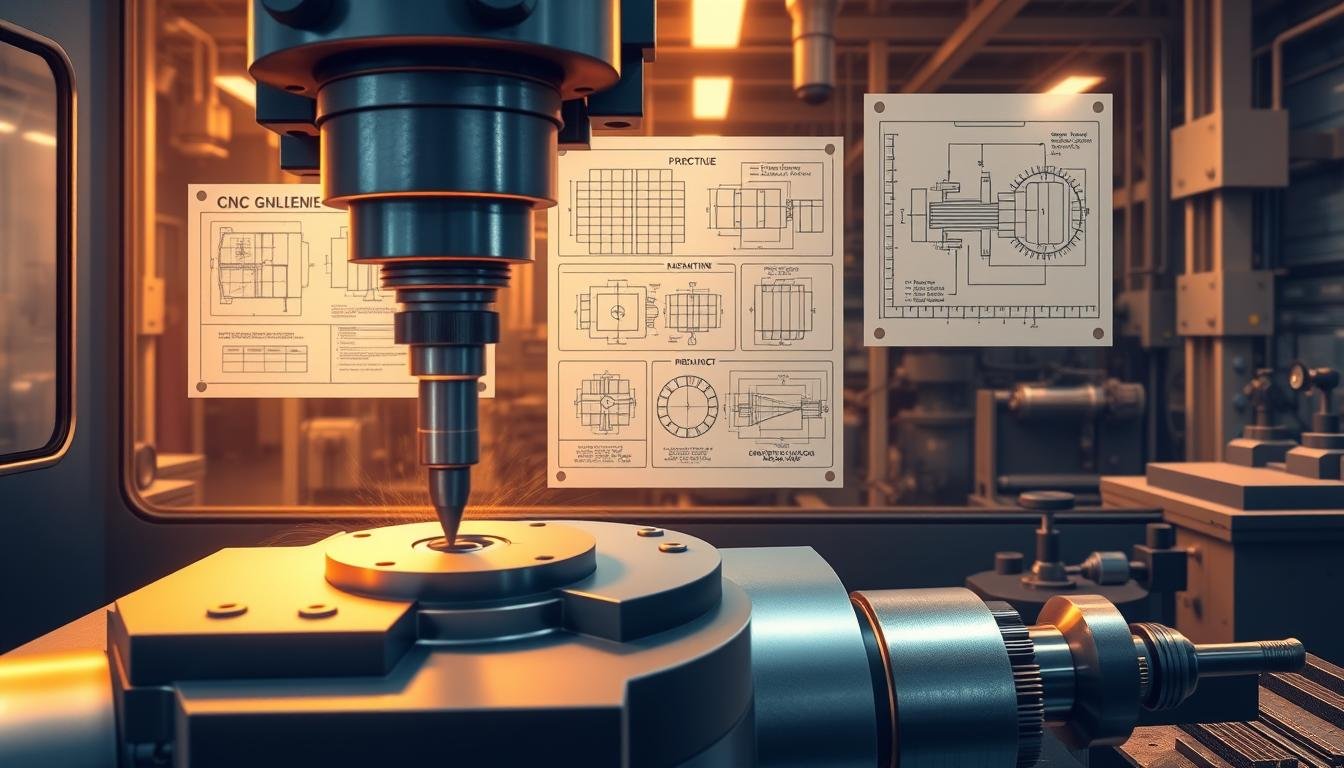CNC machining is key in making things with high precision. Our guide helps engineers make better designs. It’s all about making things faster, more accurate, and cheaper.
We use our skills to make sure our work is top-notch. This makes sure our customers are happy. By using CNC machining rules, engineers can make their work better.
Key Takeaways
- CNC machining is vital for precision manufacturing.
- Implementing best practices can significantly improve design efficiency.
- A solid understanding of design principles ensures quality outcomes.
- Optimizing designs leads to cost-effective manufacturing solutions.
- Reliable expertise fosters customer satisfaction and trust.
Understanding CNC Machining
We want to give you a full view of CNC machining. It’s a big deal in making things. It uses computers to cut out parts from solid blocks. This makes parts very precise.
Knowing how CNC machining works is key. It helps us make things better and faster.
What is CNC Machining?
CNC machining means Computer Numerical Control machining. It makes making parts easier and more accurate. It’s used in many fields, like aerospace and medical devices.
The computer control makes sure parts are the same every time. This is something manual methods can’t do.
Benefits and Limitations of CNC Machining
CNC machining has many good points. It’s very precise, which makes parts work better. You can use many materials, like metals and plastics.
It also makes making parts faster. This saves time and money.
But, CNC machining has downsides too. Making complex shapes can be expensive. The setup costs can be high, which might hurt your budget.
It’s important to know these downsides. This helps when deciding to use CNC technology.
If you want to learn more about making parts precise, check out this guide.
CNC Machining Design Guidelines
Knowing and using good CNC machining design rules is key for engineers. It helps make high-quality parts fast and saves money. Following the best design practices leads to better results and easier production.
Essential Guidelines for Engineers
Engineers need to keep these main points in mind when designing for CNC machining:
- Avoid Deep Pockets: Deep pockets make machining hard and can cause tool problems. It’s better to make shallower pockets that still work well.
- Maintain Adequate Wall Thickness: Having the same wall thickness everywhere is important. It helps avoid machining problems and keeps parts stable.
- Ensure Tool Access: Designing parts for easy tool access speeds up machining. Parts should be set up so tools can reach them easily.
Writing down designs well helps avoid mistakes during making. Talking with machining partners often gives great tips. Using these tips makes projects more successful.
Material Selection for CNC Machining

Choosing the right material for CNC machining is key for saving money and working efficiently. Prices vary a lot; for example, aluminum costs about $1 per pound, while copper is over three times that. How easy a material is to machine affects how well and fast you can make things.
Aluminum is light and strong, making it easy to work with. This means you can make things faster. Steel is strong but hard to machine, needing the right tools and speeds. Stainless steel is tough and doesn’t rust, but it’s hard to work with.
Brass is great for making electrical parts and decorations because it’s easy to machine. Titanium is strong and doesn’t rust, but it’s hard to work with. Plastics like ABS are easy to use for prototypes and everyday items. Materials like Delrin are stiff, making them good for precise parts like gears.
Material properties affect how well you can machine them. Aluminum is easy to machine, making production faster and more accurate. Stainless steel needs to be machined slowly to avoid damage. Copper is soft, so you need to control the cutting forces to avoid blemishes.
We know how important choosing the right material is for CNC machining. The material you pick affects the quality and cost of your work. For more information, check out material selection for CNC machining.
Design Considerations for CNC Machining

Designing parts for CNC machining needs a deep understanding of key factors. These factors help make the manufacturing process more efficient. By looking at geometric and tool access needs, engineers can make designs better and production smoother. Here are the main points to consider.
Geometric and Dimensional Considerations
Geometric and dimensional aspects are very important in CNC machining design. Some key points include:
- Pocket Depth: Make sure pocket depths are within tool limits to avoid tool breakage.
- Wall Thickness: Keeping wall thickness right is key for stability and easy machining.
- Avoiding Sharp Corners: Use fillets or radii instead of sharp corners to lessen stress.
Tool Access Requirements
Good tool access is crucial for CNC machining success. Meeting tool access needs can make the process more efficient and cut costs. Important points to remember are:
- Avoid Hidden Features: Design parts to avoid features that block tool access during machining.
- Unobstructed Access: Make sure tools can easily get to all machining areas without trouble.
- Tool Length and Diameter: Think about the tool’s size to ensure it can reach needed depths and angles.
By paying attention to these design points, engineers can make CNC machining smoother. This leads to better results overall.
CNC Machining Best Practices

Using CNC machining best practices can make projects more efficient and of higher quality. It’s good to use standard hole sizes. This makes tools work better together and makes production smoother.
Designs should be simple. Simple designs mean fewer mistakes and faster work times.
Changing tools less often is a key tip. Each time you change tools, there’s a chance for mistakes. This can slow down work.
Good documentation is also key. It makes sure everyone knows what to do. For example, clear drawings and notes can prevent delays.
The following table summarizes key CNC machining best practices for various aspects of the process:
| Practice | Description | Benefits |
|---|---|---|
| Standard Hole Sizes | Use common dimensions for holes in designs. | Enhanced tool compatibility and reduced setup time. |
| Design Simplicity | Avoid complex shapes and unnecessary features. | Improved machining speed and reduced error rates. |
| Minimize Tool Changes | Design parts to require fewer tools. | Reduced downtime and lower production costs. |
| Effective Documentation | Provide clear and detailed instructions. | Less miscommunication and streamlined workflows. |
Following these best practices helps make projects better and faster. This saves time and money in the long run.
CNC Machining Optimization Techniques

Modern manufacturing relies on effective CNC machining optimization. It’s all about cutting down machining time and making designs easier to make. This approach boosts production efficiency, precision, and lowers costs.
Reducing Machining Time
Shortening machining time boosts productivity and saves money. Here are some ways to do it:
- Use advanced CNC machines like 5-axis machining centers for complex shapes without extra setup.
- Optimize tool paths to cut down on unnecessary movement, speeding up cycles.
- Choose materials that are easier to work with, reducing tool wear and speeding up processes.
By focusing on these, manufacturers can make their CNC machining more efficient. This leads to faster production cycles.
Enhancing Design for Manufacturability (DFM)
Improving design for manufacturability is key for quality CNC machining. Here are some strategies:
- Follow design guidelines to simplify shapes, making machining easier.
- Use CAM software for precise programming, supporting efficient manufacturing.
- Think about CNC tech limits during design to avoid problems.
By focusing on design for manufacturability, engineers can make designs that fit production well. This improves workflow and reduces waste.
CNC Machining Specifications
CNC machining specs are key to making parts right. Following these specs ensures parts are of high quality and work well. Precision tolerances in CNC machining are at the heart of these specs. They tell us how much a part can vary from its intended size.
Several things affect CNC machining costs and specs, including:
- Material Selection: Different materials change how durable and performing a part is. They also change the machining process.
- Part Complexity: Parts with complex designs need more detailed machining. This can make production take longer and cost more.
- Post-Processing Finishes: Finishing steps can make a part’s surface better and more precise. But, they can also increase costs.
Knowing about CNC machining specs helps makers make better choices. These choices can save time and money. Focusing on precision tolerances in CNC machining leads to parts that meet customer needs.
CNC Machining Design Rules and Standards
It’s key to follow CNC machining design rules for top-notch results. Industry standards help engineers make sure everything is accurate and reliable. These rules make products better, improve workflow, and cut costs.
Industry Standards to Follow
Many important industry standards guide CNC machining. Knowing these rules helps keep products up to standard. Key ones include:
- ISO 9001: This standard is all about quality management. It helps companies make customers happy by improving their processes.
- ISO 2768: This standard gives tips on tolerances for sizes, angles, and shapes. It’s very useful.
- ASME Y14.5: The American Society of Mechanical Engineers has rules for dimensions and tolerances. They’re crucial for precise engineering drawings.
Common Design Mistakes to Avoid
Knowing what design mistakes to avoid can make production smoother. Some common errors are:
- Neglecting tool access: Not thinking about tool access can cause problems and cost more.
- Using inappropriate tolerances: Too tight tolerances waste time and might need extra work.
- Insufficient consultation with machining partners: Talking to manufacturers early helps match design with what’s possible.
Conclusion
In summary, the CNC machining design guidelines are key for engineers. They help ensure successful machining outcomes. We looked at important factors like material choice, tool access, and workholding techniques.
Using these practices improves the precision and complexity of parts. It also keeps product quality high and makes customers happy.
Our final thoughts on CNC machining stress its importance in today’s fast-changing manufacturing world. Using advanced CAD and CAM software and improving machine setup boosts performance and efficiency. Engineers should always update their methods to fit each project’s needs.
To improve your skills in CNC machining, check out this CNC machining guide. Keeping up with new information helps us all make better manufacturing solutions for our industry.
FAQ
What is the primary focus of CNC machining design guidelines?
CNC machining design guidelines aim to make designs better. They focus on efficiency, precision, and cost. This ensures designs can be made and meet industry standards.
What are the key benefits of using CNC machining?
CNC machining brings many benefits. It offers high precision and can repeat tasks well. It also works with many materials and can make complex shapes.
What limitations should engineers consider when designing for CNC machining?
Engineers need to know some limits. High costs can come with complex shapes. Also, tools need easy access, and there might be startup costs.
What are some essential design considerations for CNC machining?
Important design thoughts include keeping wall thicknesses right. Avoid deep pockets and make sure tools can reach. Also, manage shape and size carefully.
Why is material selection crucial in CNC machining?
Choosing the right material is key. It affects costs, how easy it is to machine, and quality. This choice is very important.
What are some best practices for optimizing CNC machining projects?
Good practices include using standard hole sizes and simple designs. Try to change tools less and keep good records. This helps avoid delays.
How can CNC machining processes be optimized for efficiency?
To improve, use smart tool paths and the right materials. Advanced tech like 5-axis machining helps with complex shapes.
What specifications should be considered for CNC machining?
Key specs include standard tolerances and knowing production costs. Material choice, complexity, and post-processing affect costs and time.
What industry standards should be followed in CNC machining?
It’s vital to follow industry standards for quality and safety. Avoid mistakes like bad tool access and wrong tolerances.
How can integrating CNC machining design guidelines enhance manufacturing outcomes?
Using CNC design guidelines boosts efficiency and quality. This leads to happier customers and better results.


